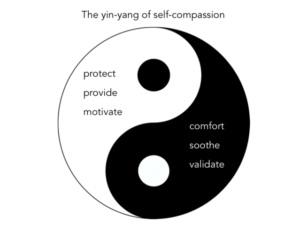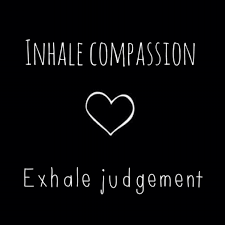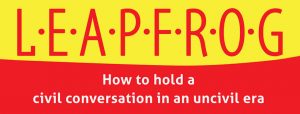We continue today with my mini series on the three words that have woven themselves into much of my work of late: Curiosity, Compassion, and Courage.
Today it’s COMPASSION’s turn. Merriam-Webster defines this noun as the “sympathetic consciousness of others’ distress together with a desire to alleviate it.”
That’s fine. In fact, every definition of compassion that I found included two parts, exemplified here in this Yin-Yang poster on self-compassion:

The challenge is to find the balance between the yin and the yang, the head and the heart, the need to care and the need to be practical, the need for mercy and the need for justice.
But how did it get to be one of my THREE Cs?
Compassion is what keeps curiosity from being nosy.
The late American teacher and “Be Here Now” guru, Ram Das, talked of balancing compassion with wisdom. One without the other will be either “mushy and exhausting” or “dry and brittle.” You can tell which is which, I think.

Compassion is not a relationship between the healer and the wounded. It’s a relationship between equals. Only when we know our own darkness well can we be present with the darkness of others. Compassion becomes real when we recognize our shared humanity.”
American Buddhist nun Pema Chödrön, in her book The Places That Scare You.
When we seek only to fix, soothe, tend, comfort, or heal, it’s easy to become exhausted or burn out. That was my point on “The Downside of Empathy” post. And yes, I now use empathy as synonymous with compassion; it’s just a difference in etiology: Greek vs. Latin.
Curiosity (what we discussed last week) pulls us to open the book, the box, the door; to explore the myth, the mantra. To initiate a conversation with someone we don’t understand. And, to do it without judgment.
Compassion, to me, is a choice we make to bring an empathetic consciousness to what we find. This can be harder than we realize, which is where courage comes in. But we’ll save that for next week.

How about you? How do you identify a feeling of compassion? Do you see it as having those two parts?
Next time: Courage
[box] LEAPFROG, my tiny handbook for handling those tricky conversations we all face, is available in digital and paperback format. The audio book is in the works.
I’m participating in Amazon Affiliates, so your purchase through my website will enable me to make a wee bit more and not increase your cost at all. The above link takes you to the LEAPFROG page on my website (not yet accessible directly) where you can learn more about the book. To skip that page and go directly to the book’s page on Amazon, click here. Thank you.
[/box]
Marian Beaman
There you are again, Janet, teaching us to be kinder and more civil. What stood out today was the line “Compassion is what keeps curiosity from being nosy.”
And that reminded me of an Anne Lamott quote. I tried googling for the exact words, but came up short. The essence though: Helping others can be a benign way to exert control. Uh-oh!
You can’t go wrong with empathy though, empathy without judgement.

Marian Beaman recently posted…Guess Who’s Turning 80 in July!
Janet Givens
“Helping others can be a benign way to exert control.” I love Ann Lamott; wish I’d known of this quote when I wrote that “downside of empathy” post. I agree. There YOU are again, Marian, bringing in an instructive link. Thanks. And HAPPY BIRTHDAY
Janet Givens recently posted…My Second C: Compassion
Marian Beaman
Pam
I think it’s easy for people to be curious. Definitely seems innate. But I think it’s much harder for people to be compassionate. To be compassionate, one needs to go outside herself, outside her own needs and wants and worries, and as the old expression goes, “wear someone else’s shoes.” I’ve wondered over the years if compassion is genetic, or maybe not genetic, but that some are born with compassion and others not. I have such a difficult time watching people think only of themselves and to seem unable to realize that we’re all “in this together.” That we all have pain and joy and needs. Compassion is the key to a better society, in my mind. Thanks Janet for a thoughtful and thought-provoking post.
Janet Givens
I apologize that it’s taken me so long to see your comment; looks like it came in on a new browser. But here we are. I think compassion is like a muscle. It needs to be exercised! They have found that we are born with “mirror neurons” which means only that we’re born with the ability to put ourselves in another’s shoes. But if that trait is not nurtured, “exercised,” it can wither. Oh dear; that does not bode well, does it. Compassion must be modeled too I think. Thanks for adding your voice here, Pam. Always good to have you.
Janet Givens recently posted…More Musings in the Era of CoViD-19
Bette Stevens
Compassion is a beautiful thing… Thank for keeping it front and center for us, Janet! I love the “inhale compassion, exhale judgement” concept. How we need those reminders!
Janet Givens
Thanks, Bette. Yes, I liked that too. I was struck by how often I found both Curiosity and Compassion (my first two Cs) required a suspension of judgment. How easy it is to slip into judgment, even when we call it “evaluation” or “assessment.” Glad you stopped by; I apologize for my lateness; I hope to soon be able to write about what’s been going on here in my life these past few months.
Janet Givens recently posted…My Second C: Compassion
Laurie Buchanan
Janet — I enjoyed reading this informative post. And yes, the tricky part is finding and maintaining BALANCE in these two parts of compassion:
(1) sympathetic consciousness of others’ distress
(2) a desire to alleviate it
Janet Givens
Balance. The wisdom to know the difference. Moderation. All so important and all so counterintuitive sometimes. Our passion intervenes I think. Thanks for stopping by, Laurie, and adding your voice.
Janet Givens recently posted…My Second C: Compassion
Joan
Oh yes, for me compassion is being able to listen without giving advice or judgement on another person’s situation. Sometimes that’s a hard lesson to learn, but oft is the only way to keep ourselves from burning out.
Janet Givens
Hi Joan. Indeed; I think real listening is a gift we give the other person. Listening without just biding our time till it’s our turn to talk, listening without judgment — all so difficult sometimes. Compassion helps. Thanks
Janet Givens recently posted…My Second C: Compassion
Arlene Smith
A piece of advice I received in the past was to try replacing the word “love” with “compassion” and see how it feels. Think of the difference in wedding vows, for example, if we’re vowing to have compassion for another person instead of love them. The root of the “com” in compassion means “with.” When you’re with someone, to me, it means you’re beside them on whatever the journey is.
Arlene Smith recently posted…Writing life
Janet Givens
Hello Arlene, Thanks for joining us. It’s always good to hear from you. I like to believe that love, like compassion, is a choice we make. So, I can see them being exchanged now and then. But just how do you use that in a sentence. How to change, “I love you” into a sentence using compassion? That is the new challenge!
Janet Givens recently posted…My Second C: Compassion